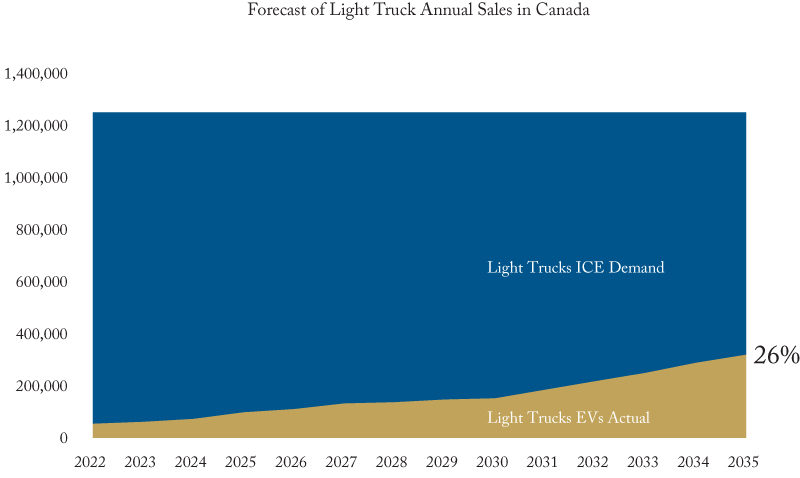To: Canadian Energy Transition Watchers
From: Brian Livingston
Date: May 9, 2023
Re: The Big Electric Light Truck Challenge
Canadian transportation policy is now operating under a Zero Emissions Vehicle (ZEV) mandate that will soon have a binding effect as Canadians try to purchase their next vehicle, particularly light trucks.
The mandate requires sellers of light vehicles – SUVs, pickups and the like – to sell a certain minimum of ZEVs in a year. The theory is that this will guarantee a market and thus encourage creation of ZEV manufacturing facilities and phase-out of internal combustion engine vehicles.
The federal ZEV mandate proposed last December states that sales of light vehicles (passenger cars and light trucks) must be at least 20-percent zero-emission in 2026, 60 percent in 2030 and 100 percent by 2035. British Columbia and Quebec have similar mandates.
The flip side to a ZEV mandate is a prohibition on the sale of internal combustion vehicles. A company has a steadily shrinking quota for the maximum number of those light vehicles it can sell in a year. If it sells more than its quota, it must either buy credits from another ZEV company, such as Tesla, or pay what is in effect a fine of $20,000 for each excess sale of an internal combustion vehicle.
Other jurisdictions have taken similar steps. In 2022, the EU mandated 100 percent ZEVs by 2035. But it recently gave an exemption to ICE vehicles that use renewable fuels – very likely because, prodded by Germany, it realized there simply will not be enough ZEVs to supply all demand in 2035.
The US Environmental Protection Agency recently announced stringent limits on auto tailpipe pollution, aiming to ensure that as many as two-thirds of all new passenger vehicle sales are electric by 2032. In response, the Wall Street Journal observed that vehicle manufacturers have ceased to be free enterprise operators and have been converted to regulated entities acting as a government tool to moderate climate change. Some even speculate that Republicans will make ZEV mandates an issue in the 2024 election campaign.
In 2022, light vehicle sales in Canada consisted of 300,000 passenger cars and 1.25 million light trucks. Canadians have shown they want to buy light trucks 80 percent of the time and passenger cars only 20 percent.
Of the 300,000 passenger cars sold in this country in 2022, 45,000 were EVs. If sales stay at 300,000, manufacturing capacity must increase by almost seven times to meet the 2035 100-percent target. My forecast, based on a bottom-up examination of future production from 20 manufacturers, shows that this 2035 target can in fact be met, along with the interim targets before 2035.
By contrast, in 2022 only 55,000 of the 1.25 million light trucks sold were EVs. To fulfil the 100 percent mandate and produce that many EV light trucks in 2035, manufacturing capacity would have to increase by almost 23 times. Just to meet the 2026 20-percent requirement would require a four-fold increase in just four years.
At the moment, however, capacity to make EV light trucks is very limited. The factory for the Tesla Cybertruck is still under construction, while the electric version of the Ford F150, of which only 15,000 were produced last year, has a customer waiting time of at least a year. As a result, my forecast is that only 320,000 ZEV light trucks will be produced in 2035 – just 26 percent of the total current demand of 1.25 million. This 74-percent gap will create a serious light truck shortage.
The result is likely to be a large number – 930,000 in 2035, to be precise – of Canadians who want to buy a light truck but cannot do so. If you thought reaction to COVID mandates was vocal, wait until you see the reaction to the ZEV mandate when people realize they can’t buy the light truck they need in order to live their lives. Some have speculated there will be an import flood of slightly used US internal-combustion light trucks. If not, prices will have to rise sharply to choke off excess demand.
The bottom line for Canadian governments? Follow the recent EU decision and back off on the prohibition of ICE light trucks in 2035.
Brian Livingston is an Executive Fellow at the School of Public Policy at the University of Calgary.
To send a comment or leave feedback, email us at blog@cdhowe.org.
The views expressed here are those of the author. The C.D. Howe Institute does not take corporate positions on policy matters.
A version of this Memo first appeared in the Financial Post.






